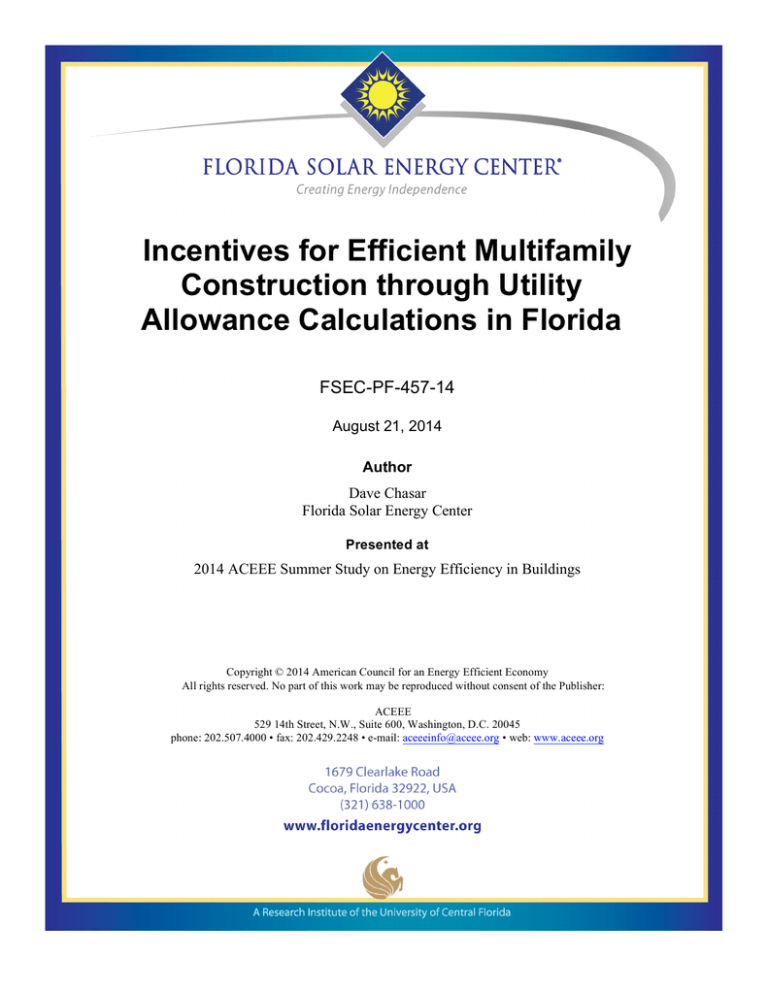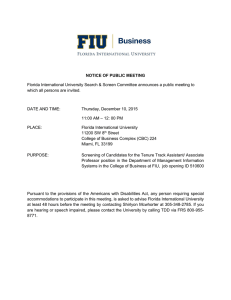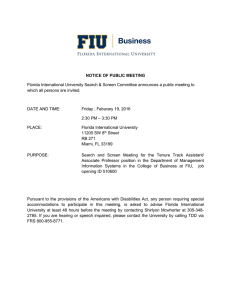Incentives for Efficient Multifamily Construction through Utility Allowance Calculations in Florida
advertisement

Incentives for Efficient Multifamily Construction through Utility Allowance Calculations in Florida FSEC-PF-457-14 August 21, 2014 Author Dave Chasar Florida Solar Energy Center Presented at 2014 ACEEE Summer Study on Energy Efficiency in Buildings Copyright © 2014 American Council for an Energy Efficient Economy All rights reserved. No part of this work may be reproduced without consent of the Publisher: ACEEE 529 14th Street, N.W., Suite 600, Washington, D.C. 20045 phone: 202.507.4000 • fax: 202.429.2248 • e-mail: aceeeinfo@aceee.org • web: www.aceee.org Disclaimer The Florida Solar Energy Center/University of Central Florida nor any agency thereof, nor any of their employees, makes any warranty, express or implied, or assumes any legal liability or responsibility for the accuracy, completeness, or usefulness of any information, apparatus, product, or process disclosed, or represents that its use would not infringe privately owned rights. Reference herein to any specific commercial product, process, or service by trade name, trademark, manufacturer, or otherwise does not necessarily constitute or imply its endorsement, recommendation, or favoring by the Florida Solar Energy Center/University of Central Florida or any agency thereof. The views and opinions of authors expressed herein do not necessarily state or reflect those of the Florida Solar Energy Center/University of Central Florida or any agency thereof. Incentives for Efficient Multifamily Construction Through Utility Allowance Calculations in Florida Dave Chasar, Florida Solar Energy Center ABSTRACT Florida recently implemented a new method for determining utility allowances for low income housing tax credit (LIHTC) properties that provide new incentives for energy efficient construction. These incentives have driven one multifamily developer to exceed minimum energy code by 40% in new developments since 2011 encompassing over 1,400 residential units in 15 properties. All new units are rated by RESNET-certified Home Energy Raters with a typical HERS index in the 50s and 60s. A unique scheme using results from the Home Energy Rating System (HERS) provides the raw data for projecting annual utility allowance figures. Details of this method are presented along with specifics of the systems-engineered package of measures driving the savings. Highlights include the successful use of heat pump water heaters, SEER 15 heat pumps, fluorescent lighting, Energy Star appliances and high performance envelope specifications. HERS results from over 1,400 units show an average value of 56, ranging from 48 to 68. Further improvement is evident in the 487 units built during 2013 with average HERS scores of 53, demonstrating the power of this incentive to push energy efficiency in a building sector that has traditionally been difficult to reach. Costs are borne by the developer and recouped through increased rents. While higher rents have the potential to decrease demand for these units, there has been no noticeable reduction in tenancy from typical levels of 95 to 100%1. Introduction Atlantic Housing Partners (AHP) is an affordable multifamily developer with a substantial portfolio of more than 24,000 units at 112 communities, primarily in Florida. AHP has participated in research with the Florida Solar Energy Center (FSEC) since 2003 steadily improving the efficiency and durability of their construction with assistance from the Building America (BA) program2. The primary goal of the BA program is to conduct research to develop market-ready energy solutions that improve the efficiency of new and existing homes by 30%50%3. The program consists of targeted research, industry partnerships, and collaboration with related DOE residential initiatives. In addition to energy savings, the program also focuses on: Improved occupant health through effective indoor air quality. Higher comfort levels in all rooms throughout the home. Durable and moisture-resistant building designs. Increased builder profitability. 1 LIHTC properties require a restricted rent structure with a fixed allowance for utilities. Increased rents are thus theoretically offset by the lower utility cost. 2 Building America is a U.S. Department of Energy program with multiple team contractors. FSEC’s team is the Building America Partnership for Improved Residential Construction (BA-PIRC). 3 As compared to 2009 energy codes for new homes and pre-retrofit energy use for existing homes ©2014 ACEEE Summer Study on Energy Efficiency in Buildings 10-33 Achievement of these goals is documented here for multifamily housing built costeffectively and on a large scale. Energy performance of the improved specification package was documented (Chasar and Martin 2013) through modeling a typical unit with Building America’s benchmarking software (BEopt E+ 1.4) as well as through hundreds of certified HERS ratings that demonstrate a consistent level of efficiency achieved. While BA has conducted similar efforts for attached housing in hot-dry (Dakin et al. 2012), cold (Aldrich 2012), and marine (Gordon et al. 2012) climates, little work has been done to demonstrate achievement of BA goals in this housing sector in hot-humid climates. A key aspect of this research includes how efficiency packages can be optimized in the context of multifamily rental housing built with the benefit of low-income housing tax credits. This funding mechanism requires restricted rents according to affordability criteria for the region plus an allowance for tenant-paid utilities. Rent can thus be increased by the amount of any reduction in the allowance. The Low-Income Housing Tax Credit (LIHTC) is an indirect Federal subsidy used to finance the development of affordable rental housing for low-income households. The program was enacted by Congress in 1986 to encourage private markets to invest in affordable rental housing. It is based on Section 42 of the Internal Revenue Code and has the following eligibility requirements (HUD 2014): Be a residential rental property. Commit to one of two possible low-income occupancy threshold requirements. Restrict rents, including utility charges, in low-income units. Operate under the rent and income restrictions for 30 years or longer. LIHTC benefits are allocated competitively at the state level where eligibility requirements, including rent plus utilities, are enforced. The allowance for each apartment’s utility cost is typically estimated by local housing authorities, based on comparable properties or by special request from a utility company. In 2010, a simulation-based alternative was introduced by the Florida Housing Finance Corporation enabling customized energy cost estimates that account for energy efficiency measures that may not be present in otherwise comparable properties. Reduced annual energy use determined by the simulation alternative provides the basis for lower monthly utility allowances and a corresponding increase in rental income for the developer. The simulation-based method provides the tailored approach needed to estimate payback of energy efficiency investments. The method described here uses the Home Energy Rating System (HERS) whereby detailed building construction and equipment information is verified through on-site audit and duct and envelope leakage performance testing. Results are documented by a certified energy rater, entered into approved software and submitted to a provider where they are subject to quality control. All levels of the rating process are overseen by the Residential Energy Services Network (RESNET) which has made steady strides since 1995 establishing a robust home energy rating industry. ©2014 ACEEE Summer Study on Energy Efficiency in Buildings 10-34 Energy Efficiency Specifications Development of the High Performance Package A critical early step to enhancing the performance of AHP multifamily units was implementing a duct sealing procedure and incorporating it into the mechanical plan section of construction documents. This included step-by-step procedures (see Appendix A) on the use of foil tape, mastic, glass fab mesh, duct board components, and flex duct take-offs, as well as guidance on sealing interfaces between ducts and drywall. As illustrated in Figure 1, proper air sealing practices during construction are particularly important where ducts are located between floors that later become difficult to access. Ducts in top floor units are located in the vented attic. Initial random duct testing revealed that many units were already meeting high performance leakage targets of 3 to 6 cubic feet per minute (CFM) per 100 ft2, but occasional outliers had much higher leakage rates. Recent duct testing results from over 1,400 units now show average leakage to out (Qn) of 0.024 or 2.4 CFM per 100 ft2 of floor area. New procedures implemented on current construction have all but eliminated high leakage outliers. Figure 1. Detail of typical air handler unit illustrating limited access to supply ducts. Source: Slocum Platts Architects, reprinted with permission. ©2014 ACEEE Summer Study on Energy Efficiency in Buildings 10-35 Figure 1 also shows details for an outside air duct which was made a standard feature in 2007 in response to high indoor humidity reported at some communities during the winter. The dedicated outside air duct provides 30 to 75 CFM (depending on apartment size) of supply ventilation to the return plenum whenever the air handler operates. This ventilation strategy introduces intermittent, limited quantities of conditioned outside air and has proved successful in thousands of Florida homes with no known moisture-related complaints reported (Chandra et al. 2008). Improved air conditioner sizing procedures were also instrumental in reducing indoor humidity levels. Cooling loads tend to vary widely with apartment size, orientation, and location in the two- to three-story designs which led to many units with over-sized cooling systems. Oversized air conditioners (A/C) tend to meet the cooling set point more quickly thus reducing dehumidification. A refined A/C sizing procedure has demonstrated size reductions of up to 1ton per apartment. Enhancement of the High Performance Package The developer spent considerable effort examining the cost-effectiveness of further efficiency upgrades. The increasing availability of heat pump water heaters (HPWH) and analysis by FSEC showing greater savings with an all-electric design resulted in the developer suspending construction of properties with gas utilities. The enhanced, all-electric package also includes a 15 SEER heat pump and progressively greater amounts of fluorescent lighting. Table 1 shows the details of this package including average performance testing results and HERS scores from 1,421 of the most recently constructed units. Table 1. Construction, equipment and performance details of 1,421 apartments recently constructed by Atlantic Housing Partners Component Construction styles Component Type and/or Value 1-story and 2-story townhomes and single level apartments in 3-story buildings Construction type Wood-frame 2 Slab-on-grade / 644 (1BR) to 1,562 (4BR) Floor type /area (ft ) Attic /roof type Vented / medium colored shingle Window type U-value 0.35, SHGC 0.30 Glass/floor area 6% to 10% Insulation attic/wall/floor R-30 / R-15 / R-0 Exterior wall cladding Medium colored cement board Space conditioning SEER 15 heat pump Thermostat Programmable Ventilation 30 to 75 CFM (runtime at return plenum) Water heater 50-gal HPWH (in all but one project)* ENERGY STAR appliances Refrigerator, dishwasher Fluorescent lighting 84% average (range: 10% to 100%) Infiltration (ACH50) 6.1 average (range: 2.3 to 13.6) Duct leakage Qn 0.034 average (range: 0.008 to 0.154) HERS Index Score 56.0 average (range 48 to 68) *Standard electric tank water heaters were used in one project totaling 90 units ©2014 ACEEE Summer Study on Energy Efficiency in Buildings 10-36 Utility Allowance Calculations Home energy rating inputs and results must be submitted to an approved provider such as the Florida Solar Energy Center (FSEC) to document and audit the process. Stored data typically include input parameters and HERS results but the rating software also generates energy outputs. The resulting simulated energy use of each individually rated unit can thus be extracted, sorted into bedroom types (i.e. 1 or 2 bedrooms, etc.) and converted into energy allowance figures. After applying local utility rates, taxes and fees, results are ready to report to the State finance agency. The developer began analyzing the cost-effectiveness of this approach with preliminary allowance figures estimated from building plans, equipment specifications and samples of building leakage performance. Various options were investigated to optimize efficiency resulting in the package detailed in Table 1. Construction specifications prior to this exercise were already above minimum energy code due to superior building envelope construction including higher levels of insulation and better windows. Optimization thus focused on equipment efficiency improvements and whether or not to include gas appliances. While including natural gas service was previously driven largely by favorable utility incentives, it now introduced an additional monthly meter fee into the allowance calculation. This and two other reasons influenced the current choice to suspend the use of gas utilities: 1) the relatively small cost of space heating in Central Florida (especially in well-constructed multifamily housing) and 2) the wider availability of heat pump water heaters. Home Energy Rating Details Rating results were compiled for 1,421 units from 15 Central Florida developments constructed between 2010 and 2013. These units had construction and equipment specifications that were largely standardized within the company except for fluorescent lighting and water heating which varied at a few projects constructed during 2011. HPWHs are being specified on all new AHP projects, but one 90-unit project used standard electric tank water heaters instead. Fluorescent lighting was used only sparingly in the past (lighting roughly 10% of floor area), but the company has experimented with higher levels on new projects and is now specifying 100% fluorescent lighting as standard. There was also a natural variation in duct and envelope tightness; however, on average, these measures were found to be adequate for high performance construction in Central Florida. Compiled HERS results yield an average score of 56.0 ranging from a low of 48 to a high of 68. Figure 2 illustrates the HERS Index score variation between the units and shows the majority of units score in the 50s. ©2014 ACEEE Summer Study on Energy Efficiency in Buildings 10-37 Figure 2. Distribution of HERS index scores for 1,421 rated units constructed from 2011 through 2013. A closer look at more recently constructed dwellings suggests a level of improvement over time. Figure 3 represents rating results of the last 487 units built during 2013. HERS for these units range from 48 to 58 with an average rating of 52.8. Figure 3. Distribution of HERS index scores for 487 rated units constructed during 2013. ©2014 ACEEE Summer Study on Energy Efficiency in Buildings 10-38 These most recently constructed units represent one third of the full sample and stand out from the rest due to substantially lower duct leakage, 100 percent fluorescent lighting and all heat pump water heaters (HPWH). The HPWH has proven the single most effective measure for reducing energy use compared to the developer’s previous standard package. Heat Pump Water Heaters: Benefits and Challenges While the energy savings benefit of HPWHs is becoming ever more evident especially in warm climates (Parker et al. 2013), they do come with unique challenges not encountered with other choices including noise, space requirements, cold air discharge and the need for a condensate drain. Quarterly maintenance is highly recommended to maintain the air filter and condensate drain. A survey of managers at the first seven communities to receive HPWHs covering over 750 installed units (Chasar and Martin 2013) yielded positive feedback overall but noise topped the list of tenant complaints. The noise issue is being addressed through architectural changes that help isolate the HPWH from occupants while allowing for air transfer with the dwelling to take advantage of the free cooling it provides. Survey results suggest general tenant acceptance of HPWHs which now amount to nearly 1,500 installed units at 16 communities. Additional problems were documented in a phone conversation with the developer’s head of maintenance (D. Sanders, National Maintenance Director, Concord Management Limited, pers. comm., March 4, 2014) which detailed intermittent problems as well as more serious issues with one HPWH model at two sites. HPWH service calls can normally be handled by on-site maintenance personnel but the complicated nature of this device sometimes requires a factorytrained technician for diagnosis. Sophisticated parts are not always readily available, requiring extended use of expensive back-up resistance water heating during downtime. In a few extreme cases where function is completely lost, a standard electric unit is needed to temporarily provide hot water. Two properties experienced more extensive HPWH failures which were handled directly by the manufacturer. A new HPWH model by the same manufacturer is claimed to be quieter and to date has experienced no major failures after installation at properties completed in 2012 and 2013. Conclusions One multifamily developer in Florida has made progressive strides to improve the efficiency and durability of their developments. Recent energy upgrades such as heat pump water heaters, 15 SEER heat pumps and increased use of fluorescent lighting enable newly constructed units to achieve 40% energy savings above the Building America Benchmark, correlating to HERS Index scores in the 50s and 60s. The commercial viability of the high performance specification package is demonstrated through widespread incorporation in over 1,400 units. This is made possible, in part, due to a simulation-based method for calculation of utility allowances available to developments funded by low-income housing tax credits. The simulation-based method assigns value to the energy savings, which are returned to the developer through increased rents. Tenants benefit from enhanced humidity control, comfort and indoor air quality resulting from a systems-engineered package which includes right-sized HVAC systems, mechanical ventilation, and performance testing of duct and envelope leakage to manage uncontrolled air flow. Heat pump water heaters are a particularly important energy ©2014 ACEEE Summer Study on Energy Efficiency in Buildings 10-39 saving component but the benefit comes with unique installation and maintenance challenges as experienced with nearly 1,500 installed units. Acknowledgements This work was conducted with support from the US Department of Energy (DOE) Building America program, under Subcontract No. KNDJ-0-40339-03. The support and encouragement of DOE program managers Eric Werling, Sam Rashkin, and David Lee, and National Renewable Energy Laboratory technical managers David Roberts and Stacey Rothgeb, are gratefully acknowledged. This support does not constitute DOE endorsement of the views expressed in this paper. Assistance gathering rating inputs and results from many hundreds of files was provided by Jeff Myron, Jody Cummings, Billy Bauman and Ryan DiMaria, all of the Florida Solar Energy Center. References Aldrich, R. 2012. Wisdom Way Solar Village: Design, Construction, and Analysis of a LowEnergy Community. Golden, CO: National Renewable Energy Laboratory. Chandra, S. D. Parker, J. Sherwin, C. Colon, K. Fonorow, D. Stroer, E. Martin, J. McIlvaine, D. Chasar, N. Moyer, S. Thomas-Rees, D. Hoak, D. Beal, and C. Gil. 2008. An Overview of Building America Industrialized Housing Partnership (BAIHP) Activities in Hot-Humid Climates, Sixteenth Symposium on Improving Building Systems in Hot and Humid Climates, December 15-17, 2008, in Dallas, TX. Chasar, D. and E. Martin. 2013. Efficient Multifamily Homes in a Hot-Humid Climate by Atlantic Housing Partners, Cocoa, FL: Florida Solar Energy Center. http://fsec.ucf.edu/en/publications/pdf/FSEC-CR-1949-13.pdf Dakin, B., C. Backman, M. Hoeschele, and A. German, 2012. West Village Community: Quality Management Processes and Preliminary Heat Pump Water Heater Performance. Golden, CO: National Renewable Energy Laboratory. Gordon, A., M. Lubliner, L. Howard, and R. Kunkle. 2012. Evaluation of Savings in Energy Efficient Public Housing in the Pacific Northwest. Golden, CO: National Renewable Energy Laboratory. Hendron, R. and C. Engebrecht. 2010. Building America House Simulation Protocols. Golden, CO: National Renewable Energy Laboratory. HUD (U.S. Department of Housing and Urban Development). " Eligibility - Affordable Housing - CPD - HUD" Accessed March 2, 2014. http://portal.hud.gov/hudportal/HUD?src=/program_offices/comm_planning/affordablehousi ng/training/web/lihtc/basics/eligibility Parker, D., D. Chasar, J. Montemurno, B. Amos, J. Cummings, J. Nelson, K. Sutherland, D. Hoak. (2013). Pilot Demonstration of Phased Retrofits in Existing Homes in Florida: ©2014 ACEEE Summer Study on Energy Efficiency in Buildings 10-40 Preliminary Data Collection and Status Update. Prepared for National Renewable Energy Laboratory. Cocoa, FL: Florida Solar Energy Center ©2014 ACEEE Summer Study on Energy Efficiency in Buildings 10-41 Appendix A – Duct Sealing Procedures ©2014 ACEEE Summer Study on Energy Efficiency in Buildings 10-42


